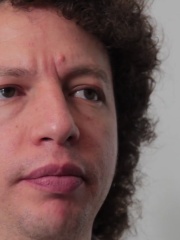


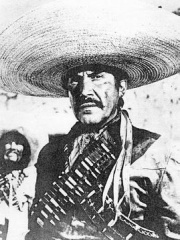
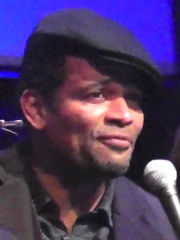
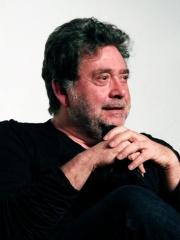
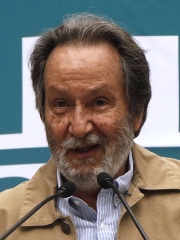

The Most Famous
FILM DIRECTORS from Mexico
This page contains a list of the greatest Mexican Film Directors. The pantheon dataset contains 2,041 Film Directors, 11 of which were born in Mexico. This makes Mexico the birth place of the 29th most number of Film Directors behind Romania, and Israel.
Top 10
The following people are considered by Pantheon to be the top 10 most legendary Mexican Film Directors of all time. This list of famous Mexican Film Directors is sorted by HPI (Historical Popularity Index), a metric that aggregates information on a biography's online popularity. Visit the rankings page to view the entire list of Mexican Film Directors.

1. Guillermo del Toro (b. 1964)
With an HPI of 67.48, Guillermo del Toro is the most famous Mexican Film Director. His biography has been translated into 65 different languages on wikipedia.
Guillermo del Toro Gómez (Spanish: [ɡiˈʝeɾmo ðel ˈtoɾo]; born 9 October 1964) is a Mexican filmmaker, author, and artist. His work has been characterized by a strong connection to fairy tales, gothicism and horror, often blending the genres, with an effort to infuse visual or poetic beauty in the grotesque. He has had a lifelong fascination with monsters, which he considers symbols of great power. He is known for pioneering dark fantasy in the film industry and for his use of insectile and religious imagery, his themes of Catholicism, celebrating imperfection, underworld motifs, practical special effects, and dominant amber lighting. Throughout his career, del Toro has shifted between Spanish-language films—such as Cronos (1993), The Devil's Backbone (2001), and Pan's Labyrinth (2006)—and English-language films, including Mimic (1997), Blade II (2002), Hellboy (2004) and its sequel Hellboy II: The Golden Army (2008), Pacific Rim (2013), Crimson Peak (2015), The Shape of Water (2017), Nightmare Alley (2021), Pinocchio (2022), and Frankenstein (2025). As a producer or writer, he has worked on the films The Orphanage (2007), Don't Be Afraid of the Dark (2010), The Hobbit film series (2012–2014), Mama (2013), The Book of Life (2014), Pacific Rim: Uprising (2018), Scary Stories to Tell in the Dark (2019), and The Witches (2020). In 2022, he created the Netflix anthology horror series Guillermo del Toro's Cabinet of Curiosities, featuring a collection of classical horror stories. With Chuck Hogan, he co-authored The Strain trilogy of novels (2009–2011), later adapted into a comic-book series (2011–15) and a live-action television series (2014–17). With DreamWorks Animation and Netflix, he created the animated franchise Tales of Arcadia, which includes the series Trollhunters (2016–18), 3Below (2018–19), and Wizards (2020), and the sequel film Trollhunters: Rise of the Titans (2021). Del Toro is close friends with fellow Mexican filmmakers Alfonso Cuarón and Alejandro G. Iñárritu, and they are collectively known as "The Three Amigos of Mexican Cinema." He has received several awards including three Academy Awards, three BAFTA Awards, two Golden Globe Awards, a Daytime Emmy Award, and a Golden Lion. He was included in Time magazine's list of the 100 most influential people in the world in 2018, and received a motion picture star on the Hollywood Walk of Fame in 2019.

2. Alfonso Cuarón (b. 1961)
With an HPI of 66.80, Alfonso Cuarón is the 2nd most famous Mexican Film Director. His biography has been translated into 68 different languages.
Alfonso Cuarón Orozco (US: kwar-OHN; Spanish: [alˈfonso kwaˈɾon] ; born 28 November 1961) is a Mexican filmmaker. His accolades include four Academy Awards, three Golden Globe Awards, seven BAFTA Awards and one Golden Lion. Cuarón made his feature film debut with the romantic comedy Sólo con tu pareja (1991), and directed the film adaptations A Little Princess (1995), and Great Expectations (1998). His breakthrough came with the coming-of-age film Y tu mamá también (2001) which earned him a nomination for the Academy Award for Best Original Screenplay and won him the Venice Film Festival Award for Best Screenplay. He gained greater prominence for directing the fantasy film Harry Potter and the Prisoner of Azkaban (2004), the dystopian drama Children of Men (2006), the science fiction drama Gravity (2013), and the semi-autobiographical drama Roma (2018). The latter two won him Academy Awards for Best Director. He also won Best Film Editing for Gravity and Best Cinematography for Roma.

3. Alejandro González Iñárritu (b. 1963)
With an HPI of 66.11, Alejandro González Iñárritu is the 3rd most famous Mexican Film Director. His biography has been translated into 66 different languages.
Alejandro González Iñárritu (born 15 August 1963) is a Mexican filmmaker primarily known for making modern psychological drama films about the human condition. His most notable films include Amores perros (2000), 21 Grams (2003), Babel (2006), Biutiful (2010), Birdman (2014), The Revenant (2015), and Bardo (2022). His projects have garnered critical acclaim and numerous accolades, including five Academy Awards. In 2006, Iñárritu became the first Mexican filmmaker to receive the Best Director Award at the Cannes Film Festival. He became the first Mexican filmmaker to be nominated as director or producer in the history of the Academy Awards, as well as the first to win for Best Original Screenplay and Best Picture. In 2019, Iñárritu served as the first Latin American president of the jury for the 72nd Cannes Film Festival. In 2015, Iñárritu was awarded the Academy Award for Best Director for Birdman (2014) and a year later received the same award for The Revenant (2015), making him the third director to win the award back-to-back, following in the footsteps of John Ford and Joseph L. Mankiewicz. To date, he is the only director in history to have won the DGA Award for Outstanding Directing two years in a row. Iñárritu was later awarded a Special Achievement Academy Award for his virtual reality installation Carne y Arena (2017), the first ever VR installation to be presented at the Cannes Film Festival.

4. Emilio Fernández (1904 - 1986)
With an HPI of 63.85, Emilio Fernández is the 4th most famous Mexican Film Director. His biography has been translated into 33 different languages.
Emilio "El Indio" Fernández Romo (Spanish: [eˈmiljo feɾˈnandes ˈromo]; 26 March 1904 – 6 August 1986) was a Mexican film director, actor and screenwriter. He was one of the most prolific film directors of the Golden Age of Mexican cinema in the 1940s and 1950s. He is best known for his work as director of the film María Candelaria (1944), which won the Palme d'Or award at the 1946 Cannes Film Festival. As an actor, he worked in numerous film productions in Mexico and in Hollywood. He was the father of the Mexican actor Jaime Fernández.
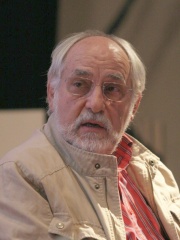
5. Arturo Ripstein (b. 1943)
With an HPI of 57.92, Arturo Ripstein is the 5th most famous Mexican Film Director. His biography has been translated into 23 different languages.
Arturo Ripstein y Rosen (born December 13, 1943) is a Mexican film director and screenwriter. Considered the "Godfather of independent Mexican cinema", Ripstein's work is generally characterized by "somber, slow-paced, macabre melodramas tackling existential loneliness", often with a grotesque-like edge. He is a nine-time Ariel Award winner, including five for Best Picture and two for Best Director. Three of his films have been nominated for the Palme d'Or at the Cannes Film Festival. In 1997, he received the prestigious National Prize for Arts and Sciences for his contributions to Mexican cinema. He was the second filmmaker (after Luis Buñuel) to receive that honour.

6. Mario Van Peebles (b. 1957)
With an HPI of 55.81, Mario Van Peebles is the 6th most famous Mexican Film Director. His biography has been translated into 30 different languages.
Mario Cain Van Peebles (born January 15, 1957) is a Mexican-born American actor and director. He is the son of Melvin Van Peebles, whom he had played in the 2003 biopic Baadasssss!, which he also co-wrote, produced, and directed. He also starred in Heartbreak Ridge (1986), New Jack City (1991), and USS Indianapolis: Men of Courage (2016), the latter two of which he had directed.

7. Guillermo Navarro (b. 1955)
With an HPI of 52.87, Guillermo Navarro is the 7th most famous Mexican Film Director. His biography has been translated into 19 different languages.
Guillermo Jorge Navarro Solares, AMC, ASC (born July 29, 1955) is a Mexican cinematographer and television director. He had been a frequent collaborator of Robert Rodriguez and Guillermo del Toro, with his work on Pan's Labyrinth earning him the Academy Award for Best Cinematography. After making directing debut with a music video for Mia Maestro titled "Blue Eyed Sailor", Navarro then shifted to a career as a TV director of series like Hannibal and Luke Cage, and was an executive producer on the National Geographic documentary series Hostile Planet, for which he earned his first Primetime Emmy nomination.

8. Jorge Fons (1939 - 2022)
With an HPI of 51.97, Jorge Fons is the 8th most famous Mexican Film Director. His biography has been translated into 17 different languages.
Jorge Fons Pérez (23 April 1939 – 22 September 2022) was a Mexican film director. He belonged to the first generation of film directors of the National Autonomous University of Mexico (UNAM). His short film, Caridad (1973), is still considered one of the best films in Mexican cinema. Two of the most important films of his filmography are Rojo amanecer (1989) and El callejón de los milagros (1995) based on the homonymous book by Naguib Mahfouz, Midaq Alley of 1947 (زقاق المدق), which breaks the classic lineal plots in films. His 1976 film, Los albañiles, won the Silver Bear at the 27th Berlin International Film Festival. In 1995, his film El callejón de los milagros won a Special Mention at the 45th Berlin International Film Festival. Fons died in Mexico City on 22 September 2022, at the age of 83.

9. Rodrigo Prieto (b. 1965)
With an HPI of 50.06, Rodrigo Prieto is the 9th most famous Mexican Film Director. Her biography has been translated into 20 different languages.
Rodrigo Prieto Stambaugh (born November 23, 1965) is a Mexican cinematographer and film director. He has collaborated with Martin Scorsese and Alejandro González Iñárritu, among other prominent directors. He is a member of both the Mexican Society of Cinematographers and the American Society of Cinematographers. Throughout his career, Prieto has received many awards and nominations, including four Academy Award nominations for Best Cinematography in Ang Lee's Brokeback Mountain (2005) and Martin Scorsese's Silence (2016), The Irishman (2019), and Killers of the Flower Moon (2023).

10. Carlos Reygadas (b. 1971)
With an HPI of 49.52, Carlos Reygadas is the 10th most famous Mexican Film Director. Her biography has been translated into 18 different languages.
Carlos Reygadas Castillo (Spanish pronunciation: [ˈkaɾlos rejˈɣaðas]; born October 10, 1971) is a Mexican filmmaker. Influenced by existentialist art and philosophy, Reygadas' movies feature spiritual journeys into the inner worlds of his main characters, through which themes of love, suffering, death, and life's meaning are explored. Reygadas has been described as "the one-man third wave of Mexican cinema"; his works are known for their expressionistic cinematography, long takes, and emotionally charged stories. His first and third films, Japón (2002) and Silent Light (2007), made him one of Latin America's most prominent writer-directors, with various critics having named Silent Light as one of the best films of its decade. His films Battle in Heaven (2005) and Post Tenebras Lux (2012) divided critics. He has co-produced other directors such as Amat Escalante (Sangre, Los Bastardos, Heli) or Pedro Aguilera (The Influence).
People
Pantheon has 11 people classified as Mexican film directors born between 1904 and 1979. Of these 11, 9 (81.82%) of them are still alive today. The most famous living Mexican film directors include Guillermo del Toro, Alfonso Cuarón, and Alejandro González Iñárritu. The most famous deceased Mexican film directors include Emilio Fernández, and Jorge Fons.
Living Mexican Film Directors
Go to all RankingsGuillermo del Toro
1964 - Present
HPI: 67.48
Alfonso Cuarón
1961 - Present
HPI: 66.80
Alejandro González Iñárritu
1963 - Present
HPI: 66.11
Arturo Ripstein
1943 - Present
HPI: 57.92
Mario Van Peebles
1957 - Present
HPI: 55.81
Guillermo Navarro
1955 - Present
HPI: 52.87
Rodrigo Prieto
1965 - Present
HPI: 50.06
Carlos Reygadas
1971 - Present
HPI: 49.52
Michel Franco
1979 - Present
HPI: 48.78

